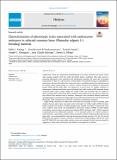| dc.description.abstract | Anthracnose caused by Colletotrichum lindemuthianum is the major common bean disease worldwide causing complete yield loss under favourable disease conditions. This study aimed to determine phenotypic traits associated with anthracnose resistance for future use in breeding programmes. Twenty-two common bean varieties (CBVs) were selected basing on susceptibility to anthracnose, advanced breeding lines, improved variety resembling advanced breeding lines and the farmer variety widely grown in Tanzania. Selected varieties were planted in anthracnose hotspot fields and the same CBVs were planted in a screen house to validate resistance to anthracnose. Anthracnose infection score, leaf length, leaf width, length of fifth internode, length of petiole, plant vigour, canopy height and canopy width were recorded. Data on number of plants emerging; days to flowering; days to maturity; plant stands at harvest; and grain yield were also collected and analysed using R software. Phenotypic traits evaluated differed significantly among genotypes, environment and genotype by environment interaction. Seventy-five percent of phenotypic traits evaluated were positively correlated to anthracnose resistance.
Highly-strong correlations to anthracnose were observed on number of days to maturity, plant stands at harvest, plant vigour and grain yield. Leaf length, leaf width, length of fifth internode, length of petiole and number of stands emerging were strongly correlated to anthracnose resistance. Additive main effects and multiplicative interaction analysis (AMMI) revealed highest contribution of environment on anthracnose infection-58.9% and grain yield −84.9% compared to genotype effects on anthracnose infection −32.7% and grain yield-15.7%. Based on these results, four traits – plant vigour, number of days to maturity, number of plant stands at harvest and grain yield – are recommended for selecting anthracnose-resistant varieties. NUA 48, NUA 64 and RWR 2154 were superior varieties, resistant to anthracnose and high yielding, while Sweet Violet and VTT 923-23-10 were most stable varieties across environments. Further on-farm research is suggested to assess their performance and identify traits preferred by farmers. | en_US |

